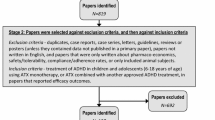Abstract
Subjective improvement-assessment in attention deficit/hyperactivity disorder (ADHD), following a single dose of methylphenidate (MPH) was compared to performance on the Test-of-Variables-of-Attention (TOVA). Self-perception was assessed with the clinical-global-impression-of-change (CGI-C). Participants included 165 ADHD subjects (M:F ratio 67%:33%) aged 5–18 (11.09 ± 3.43) years. TOVA was administered before and after MPH challenge (0.3 mg/kg). Self-perception CGI-C scores were compared to the TOVA scores. An inverse correlation was found only between CGI-C and the TOVA-Commission-scores (r = −0.326, p < 0.001). We thus conclude that subjective reports are too unreliable to be used in order to assess MPH benefit in ADHD pediatric populations.
Similar content being viewed by others
References
Biederman J, Faraone SV (2005) Attention-deficit hyperactivity disorder. Lancet 366(9481):237–248
Biederman J (2005) Attention-deficit/hyperactivity disorder: a selective overview. Biol Psychiatry 57(11):1215–1220
Greenhill L, Beyer DH, Finkleson J, Shaffer D, Biederman J, Conners CK et al (2002) Guidelines and algorithms for the use of methylphenidate in children with Attention-Deficit/ Hyperactivity Disorder. J Atten Disord 6 (Suppl 1):S89–S100
Buitelaar JK, Kooij JJ (2000) Attention deficit hyperactivity disorder (ADHD): etiology, diagnosis and treatment. Ned Tijdschr Geneeskd 144(36):1716–1723
Shah M, Cork C, Chowdhury U (2005) ADHD: assessment and intervention. Community Pract 78(4):129–132
Brewis A (2002) Social and biological measures of hyperactivity and inattention: are they describing similar underlying constructs of child behavior? Soc Biol 49(1–2):99–115
Greenberg LM, Waldman ID (1993) Developmental normative data on the test of variables of attention (T.O.V.A.). J Child Psychol Psychiatry 34(6):1019–1030
Greenberg LM (1987) An objective measure of methylphenidate response: clinical use of the MCA. Psychopharmacol Bull 23(2):279–282
Leark RA, Dupuy TR, Greenberg LM, Corman CL, Kindschi CL (1996) TOVA test of variables of attention. Professional manual. Version 7 ed. Los Alamitos: Universal Attention Disorders, Inc
Llorente AM, Amado AJ, Voigt RG, Berretta MC, Fraley JK, Jensen CL et al (2001) Internal consistency, temporal stability, and reproducibility of individual index scores of the Test of Variables of Attention in children with attention-deficit/hyperactivity disorder. Arch Clin Neuropsychol 16(6):535–546
Lubar JF, White JN Jr, Swartwood MO, Swartwood JN (1999) Methylphenidate effects on global and complex measures of EEG. Pediatr Neurol 21(3):633–637
Forbes GB (1998) Clinical utility of the Test of Variables of Attention (TOVA) in the diagnosis of attention-deficit/hyperactivity disorder. J Clin Psychol 54(4):461–476
Aggarwal A, Lillystone D (2000) A follow-up pilot study of objective measures in children with attention deficit hyperactivity disorder. J Paediatr Child Health 36(2):134–138
Rugino TA, Copley TC (2001) Effects of modafinil in children with attention-deficit/hyperactivity disorder: an open-label study. J Am Acad Child Adolesc Psychiatry 40(2):230–235
Huang YS, Chao CC, Wu YY, Chen YY, Chen CK (2007) Acute effects of methylphenidate on performance during the Test of Variables of Attention in children with attention deficit/hyperactivity disorder. Psychiatry Clin Neurosci 61(3):219–225
Wu YY, Huang YS, Chen YY, Chen CK, Chang TC, Chao CC (2007) Psychometric study of the test of variables of attention: preliminary findings on Taiwanese children with attention-deficit/hyperactivity disorder. Psychiatry Clin Neurosci 61(3):211–218
Thapar AK, Thapar A (2003) Attention-deficit hyperactivity disorder. Br J Gen Pract 53(488):225–230
Lijffijt M, Kenemans JL, ter Wal A, Quik EH, Kemner C, Westenberg H et al (2006) Dose-related effect of methylphenidate on stopping and changing in children with attention-deficit/hyperactivity disorder. Eur Psychiatry 21(8):544–547
American Psychiatric Association (2000) Diagnostic and statistical manual of mental disorders, 4th edn. American Psychiatric Association Press, Washington
Conners CK, Sitarenios G, Parker JD, Epstein JN (1998) Revision and restandardization of the Conners Teacher Rating Scale (CTRS-R): factor structure, reliability, and criterion validity. J Abnorm Child Psychol 26(4):279–291
Conners CK, Sitarenios G, Parker JD, Epstein JN (1998) The revised Conners’ Parent Rating Scale (CPRS-R): factor structure, reliability, and criterion validity. J Abnorm Child Psychol 26(4):257–268
Goodman R (2001) Psychometric properties of the strengths and difficulties questionnaire. J Am Acad Child Adolesc Psychiatry 40(11):1337–1345
Barkley RA, DuPaul GJ, McMurray MB (1991) Attention deficit disorder with and without hyperactivity: clinical response to three dose levels of methylphenidate. Pediatrics 87(4):519–531
Brown RT, Amler RW, Freeman WS, Perrin JM, Stein MT, Feldman HM et al (2005) Treatment of attention-deficit/hyperactivity disorder: overview of the evidence. Pediatrics 115(6):e749–e757
National Institute of Mental Health (1970) CGI: Clinical Global Impressions. In: Guy W, Bonato RR (eds) Manual for the ECDEU assessment battery, 2nd edn. National Institute of Mental Health p. 12–1–12–6
Author information
Authors and Affiliations
Corresponding author
Rights and permissions
About this article
Cite this article
Manor, I., Meidad, S., Zalsman, G. et al. Objective Versus Subjective Assessment of Methylphenidate Response. Child Psychiatry Hum Dev 39, 273–282 (2008). https://doi.org/10.1007/s10578-007-0087-0
Received:
Accepted:
Published:
Issue Date:
DOI: https://doi.org/10.1007/s10578-007-0087-0




